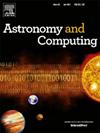揭示不确定性的力量:探索贝叶斯神经网络的恒星年代测定之旅
IF 1.8
4区 物理与天体物理
Q2 ASTRONOMY & ASTROPHYSICS
引用次数: 0
摘要
背景:天文学和天体物理学要求严格处理不确定性,以确保结果的可信度。人工智能的日益融合为解决这一需求提供了一条新的途径。这种融合为创建能够量化各种不确定性来源和自动化复杂数据关系探索的高级模型提供了机会。内容:我们引入了一个分层贝叶斯架构,其概率关系由神经网络建模,旨在预测恒星属性,如质量、半径和年龄(我们的主要目标)。该体系结构处理来自测量的观测不确定性和预测模型本身固有的认知不确定性。因此,我们的系统生成的分布封装了我们预测的潜在值范围,提供了对其可变性和鲁棒性的全面理解。方法:我们的重点是使用一种被称为化学时钟的技术来确定主序星的年代,这既是我们的主要天文挑战,也是一个模型原型。在这项工作中,我们使用分层架构来解释恒星参数之间的相关性,并从我们的数据集中优化信息提取。我们还采用贝叶斯神经网络,因为它们在捕获复杂数据关系方面具有通用性和灵活性。结果:通过将我们的机器学习算法集成到贝叶斯框架中,我们成功地一致传播了错误,并有效地管理了不确定性处理,从而产生了具有更大不确定性边际的预测。这种方法有助于对恒星年代进行更保守的估计。我们的架构在测试数据集中实现了年龄预测,平均绝对误差小于1 Ga。本文章由计算机程序翻译,如有差异,请以英文原文为准。
Unveiling the power of uncertainty: A journey into Bayesian Neural Networks for stellar dating
Context:
Astronomy and astrophysics demand rigorous handling of uncertainties to ensure the credibility of outcomes. The growing integration of artificial intelligence offers a novel avenue to address this necessity. This convergence presents an opportunity to create advanced models capable of quantifying diverse sources of uncertainty and automating complex data relationship exploration.
What:
We introduce a hierarchical Bayesian architecture whose probabilistic relationships are modeled by neural networks, designed to forecast stellar attributes such as mass, radius, and age (our main target). This architecture handles both observational uncertainties stemming from measurements and epistemic uncertainties inherent in the predictive model itself. As a result, our system generates distributions that encapsulate the potential range of values for our predictions, providing a comprehensive understanding of their variability and robustness.
Methods:
Our focus is on dating main sequence stars using a technique known as Chemical Clocks, which serves as both our primary astronomical challenge and a model prototype. In this work, we use hierarchical architectures to account for correlations between stellar parameters and optimize information extraction from our dataset. We also employ Bayesian neural networks for their versatility and flexibility in capturing complex data relationships.
Results:
By integrating our machine learning algorithm into a Bayesian framework, we have successfully propagated errors consistently and managed uncertainty treatment effectively, resulting in predictions characterized by broader uncertainty margins. This approach facilitates more conservative estimates in stellar dating. Our architecture achieves age predictions with a mean absolute error of less than 1 Ga for the stars in the test dataset.
求助全文
通过发布文献求助,成功后即可免费获取论文全文。
去求助
来源期刊

Astronomy and Computing
ASTRONOMY & ASTROPHYSICSCOMPUTER SCIENCE,-COMPUTER SCIENCE, INTERDISCIPLINARY APPLICATIONS
CiteScore
4.10
自引率
8.00%
发文量
67
期刊介绍:
Astronomy and Computing is a peer-reviewed journal that focuses on the broad area between astronomy, computer science and information technology. The journal aims to publish the work of scientists and (software) engineers in all aspects of astronomical computing, including the collection, analysis, reduction, visualisation, preservation and dissemination of data, and the development of astronomical software and simulations. The journal covers applications for academic computer science techniques to astronomy, as well as novel applications of information technologies within astronomy.
 求助内容:
求助内容: 应助结果提醒方式:
应助结果提醒方式:


